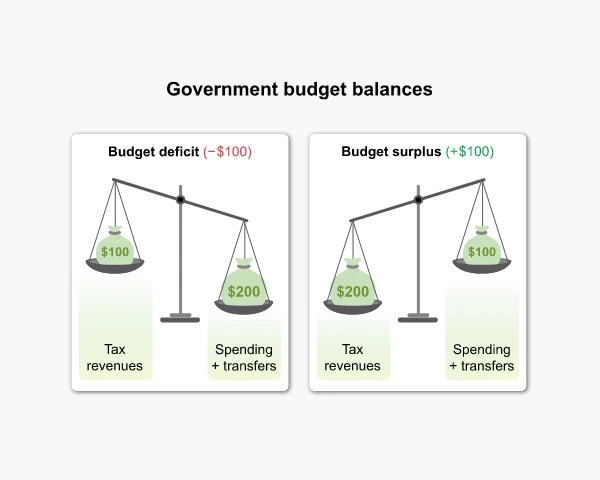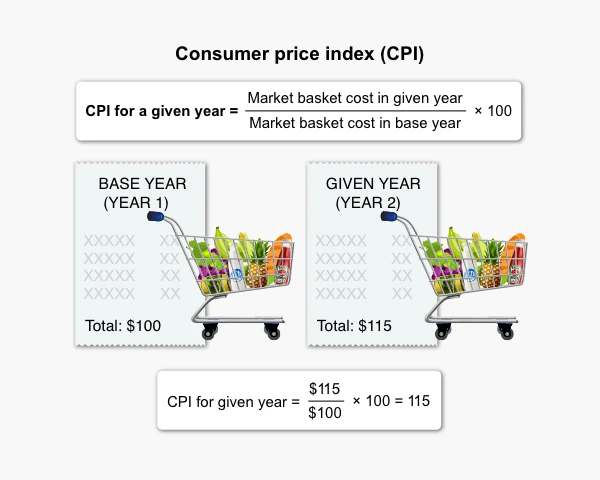AP Macroeconomics Units, Topics, and Key Concepts
Let’s start by asking, “how many units are there in the AP Macroeconomics course?” According to College Board®’s AP Macroeconomics Course and Exam Description, there are six units in the course, and they revolve around four overarching themes or big ideas that will introduce you to college-level macroeconomics.
You’ll also master specific skills as you journey through the course content. We’ll go through all of them, but first, let’s answer a couple of commonly asked questions about the AP Macro course:
Is it a one-semester course or a dual credit course in high school?
AP courses are different from dual credit courses. AP Macroeconomics is not a dual credit course and is typically a one-semester course.
Which college course is equivalent to the AP Macro course?
AP Macroeconomics is equivalent to a first-semester college course in macroeconomics.

The Four Big Ideas of AP Macroeconomics
The big ideas are the fundamental themes of the AP Macroeconomics curriculum. Each unit and topic you learn covers one or more of these recurring themes. The AP Macro course consists of four big ideas; let’s learn about each of them below:
-
Big Idea 1: Economic Measurements (MEA)
These are metrics developed by economists to measure and observe the condition of an economy and assess its progress over time. Governments, companies, and individuals frequently use these measurements to assist in shaping policies, making business choices, and informing personal decisions.
-
Big Idea 2: Markets (MKT)
This big idea includes the concept of markets. You’ll learn how buyers and sellers come together to trade goods and services, benefiting both parties in competitive markets. The basic concept of supply and demand can be applied in various market settings.
-
Big Idea 3: Macroeconomic Models (MOD)
Under this big idea, you’ll learn about macroeconomic models and how they can be used to forecast and explain fundamental economic connections. You will also learn about their relationship with economic disruptions.
-
Big Idea 4: Macroeconomic Policies (POL)
The fourth big idea deals with the relationship between government taxation, spending policies, and the monetary policies of a country’s central bank. It also addresses how these policies affect the economy's output, pricing structures, and employment level in the short and long terms.
AP Macroeconomics - Six Units and Topics
As you may recall, there are 6 AP Macro units. These units, along with the big ideas and course skills, are designed to help you build a solid foundation for college-level macroeconomics and prepare for the AP Macroeconomics exam.
UNIT 1: Basic Economic Concepts
Exam Weighting: 5 – 10% | Class periods ~ 8 – 10
Big Ideas Incorporated:-
Big Idea 2: Markets (MKT)
- What is resource scarcity, and why do people and societies need to trade?
- What determines the market price for a good or service?
-
Big Idea 3: Macroeconomic Models (MOD)
How do models like the production possibilities curve (PPC) help us determine tradeoffs, scarcity, employment, and economic growth?
Unit 1 will introduce you to fundamental concepts in economics, like markets, supply and demand, and the exchange of resources. You’ll learn models and concepts that you’ll apply in subsequent units.
In this unit, you’ll learn:
- Most resources are scarce, and people must make choices to prioritize access to some of them, thus creating trade-offs and a cycle of supply and demand. Topics 1.1 - 1.5
- How supply and demand impact market equilibrium and the price of a resource or service: Topic 1.6
UNIT 2: Economic Indicators and the Business Cycle
Exam Weighting: 12 – 17% | Class periods ~ 9 – 11
Big Idea Incorporated:
Big Idea 1: Economic Measurements (MEA)
- What are the indicators of a healthy or poor economy?
- How does money flow inside an economic system to create the cycle of income and expenditure?
Unit 2 will use the macroeconomic concepts you learned in Unit 1 and teach you to apply those concepts to understand the circular flow of money, GDP, unemployment, inflation, and business cycles.
In this unit, you’ll learn to:
- Describe economic concepts, principles, and models to understand GDP and unemployment: Topics 2.1 - 2.3
- How macroeconomic models are used to determine inflation, business cycles, and the overall health of a country’s economy: Topics 2.4 - 2.7
UNIT 3: National Income and Price Determination
Exam Weighting: 17 – 27% | Class periods ~ 10 – 12
Big Ideas Incorporated:
-
Big Idea 3: Macroeconomic Models (MOD)
How do the choices people make about spending and producing things impact the economy? This includes decisions made by households, businesses, the government, and other countries. -
Big Idea 4: Macroeconomic Policies (POL)
- Who determines the price of products and services in an economy?
- How do taxation policies and the choices made by the government about spending money affect a country’s economy?
In this unit, you will learn about an economic model called the aggregate demand–aggregate supply model. This model helps economists understand how different factors, such as spending decisions, production choices, economic fluctuations, and government policies, affect important economic measures such as output, income, unemployment, and inflation.
Topics covered in this unit include:
- Learning and understanding how the aggregate supply model is used to determine production decisions, economic fluctuations, and policy actions on macroeconomic outcomes, including output, income, unemployment, and inflation: Topics 3.1 - 3.8
- Exploring the effects of a government’s fiscal policy on the country’s economy: Topic 3.9
UNIT 4: Financial Sector
Exam Weighting: 18 – 23% | Class periods ~ 11 - 13
Big Ideas Incorporated:
-
Big Idea 1: Economic Measurements (MEA)
What is currency? -
Big Idea 2: Markets (MKT)
How is the price of currency determined? -
Big Idea 4: Macroeconomic Policies (POL)
- How do banks create currency?
- How do the actions of a country’s central bank affect financial decision-making and the economy?
Unit 4 begins with an understanding of currency: what it is, how its value is determined, and how it is created. With this knowledge, you’ll learn how the financial sector works and how monetary policy is implemented and transmitted through the banking system.
Topics covered in Unit 4 include:
- An overview of financial assets, such as currency, interest rates, and their functions: Topics 4.1 - 4.3
- How fractional reserve banking enables the growth of the money available in circulation and how monetary policy is implemented and transmitted through the banking system: Topic 4.4
- Assessing the impact of monetary policy on the overall economy by examining the dynamics of money market, reserve market, and loanable funds market through modeling techniques: Topics 4.5 - 4.7
UNIT 5: Long-Run Consequences of Stabilization Policies
Exam Weighting: 20 – 30% | Class periods ~ 8 - 10
Big Ideas Incorporated:
-
Big Idea 1: Economic Measurements (MEA)
How does an economy grow? -
Big Idea 3: Macroeconomic Models (MOD)
What is the relationship between inflation and unemployment? -
Big Idea 4: Macroeconomic Policies (POL)
How do monetary and fiscal policies affect the economy in the long run?
Unit 5 builds on the concepts acquired in Units 2, 3, and 4 and requires you to apply and utilize these concepts. This unit involves analyzing the long-term consequences of policy measures and exploring the notion of economic growth. Additionally, the unit delves into using the Phillips curve model to depict the correlation between inflation and unemployment in both the short and long term.
Topics covered in Unit 5 include:
- How fiscal and monetary policies affect a country’s economy in the short and long run: Topics 5.1 and 5.3 - 5.5
- Use the Phillips curve model to analyze how macroeconomic shocks impact inflation and unemployment: Topic 5.2
- The impact of public policy and periods of expansion and contraction on economic growth: Topics 5.6 - 5.7
UNIT 6: Open Economy—International Trade and Finance
Exam Weighting: 10 – 13% | Class periods ~ 5 - 7
Big Ideas Incorporated:
-
Big Idea 1: Economic Measurements (MEA)
Why does the balance of payments always equalize? -
Big Idea 2: Markets (MKT)
- Why does the price of one nation’s currency relative to another nation’s currency fluctuate?
- How do changes in the value of a country’s currency impact its economy?
In Unit 6, you’ll explore the concept of an open economy where countries interact with the world through product and financial markets, including currency exchange rates. You’ll also learn how economic activity affects currency supply, demand, and value.
Topics covered:
- Balance of payments accounts: Topic 6.1
- Currency exchange rates, foreign exchange market, and the effects of fiscal policy on the exchange market: Topics 6.2 - 6.5
- Interest rates and the flow of capital across countries: Topic 6.6

What Are AP Macroeconomics Course Skills?
Mastering the AP Macro course also requires you to learn a series of course skills listed by the College Board. The course combines these practices with the course content you learn in class so you can use these skills during the AP exam. Let's see what these AP Macroeconomics course skills are:
Principles and Models
The first-course skill requires you to identify and describe economic concepts, principles, or models and illustrate your understanding through examples, quantitative data, or calculations. In addition to analyzing these AP Macroeconomics key concepts, you’ll also need to describe their similarities, differences, and limitations.
-
Interpretation
The second skill builds off of the first one and requires you to explain specific economic outcomes using concepts, principles, or models.
-
Manipulation
While the previous skill focuses on explaining a given outcome, this course skill requires you to determine an outcome(s) using the AP Macroeconomics key concepts, models, and quantitative data presented to you.
-
Graphing and Visuals
To master the final skill, you’ll have to successfully draw accurately labeled graphs and charts to represent an economic situation presented to you. You’ll need to take into account any changes to that economic situation before representing it through your model or graph.
Get ahead in AP Macroeconomics with our complete prep course, including an in-depth study guide and an extensive QBank with realistic, exam-style questions.
Frequently Asked Questions (FAQs)
What are the most important topics in AP Macroeconomics?
- Unit 5: Long-Run Consequences of Stabilization Policies
- Unit 4: Financial Sector
- Unit 3: National Income and Price Determination
Can I take the AP Macroeconomics exam without taking the course?
What is the hardest unit in AP Macroeconomics?
References
- AP Macroeconomics Course Overview. (2022). apcentral.collegeboard.org. Retrieved December 9, 2024, from https://apcentral.collegeboard.org/media/pdf/ap-macroeconomics-course-overview.pdf
- AP Macroeconomics Exam – AP. (n.d.). apcentral.collegeboard.org. Retrieved December 9, 2024, from https://apcentral.collegeboard.org/courses/ap-macroeconomics/exam
- AP® Macroeconomics Course and Exam Description. (Fall, 2022). apcentral.collegeboard.org. Retrieved December 9, 2024, from https://apcentral.collegeboard.org/media/pdf/ap-macroeconomics-course-and-exam-description.pdf
- Trevor Packer. (June 20, 2024). twitter.com. Retrieved December 9, 2024, from https://x.com/AP_Trevor/status/1803799954168713324
Read More About AP Macroeconomics
Crush the AP Macroeconomics exam with our expert’s comprehensive guide. From customized study plans to expert test-taking strategies, we've got everything you need to succeed!
About AP Macroeconomics ExamWant a quick rundown on what to expect on the AP Macroeconomics exam? This complete exam guide includes detailed exam info, prerequisites, syllabus, difficulty, and more!
AP Macroeconomics Scoring GuideGet a better understanding of the AP Macro exam scoring system with our guide. Learn about the scoring rubric, what constitutes a passing score, and how to interpret your results.
AP Macroeconomics Exam FormatDon't let the AP Macro exam catch you off guard. This guide covers everything you need—the number and types of questions, section format, time limit per question, and more.

